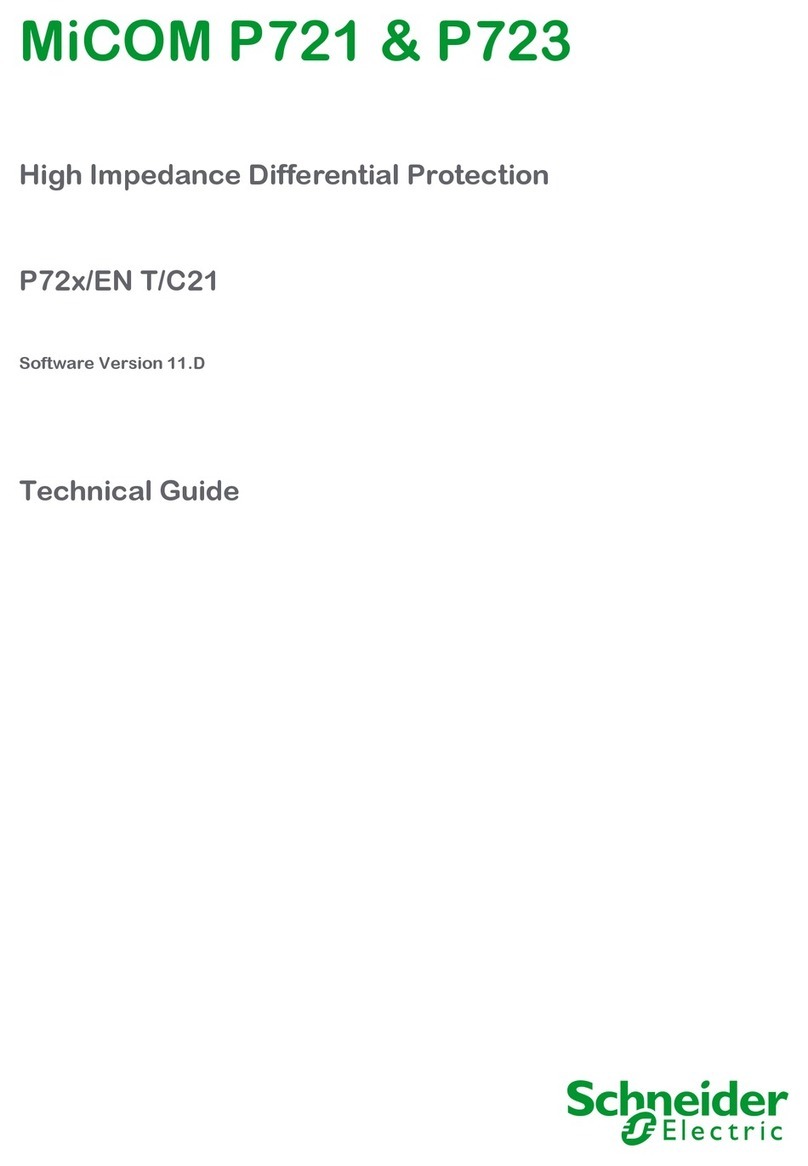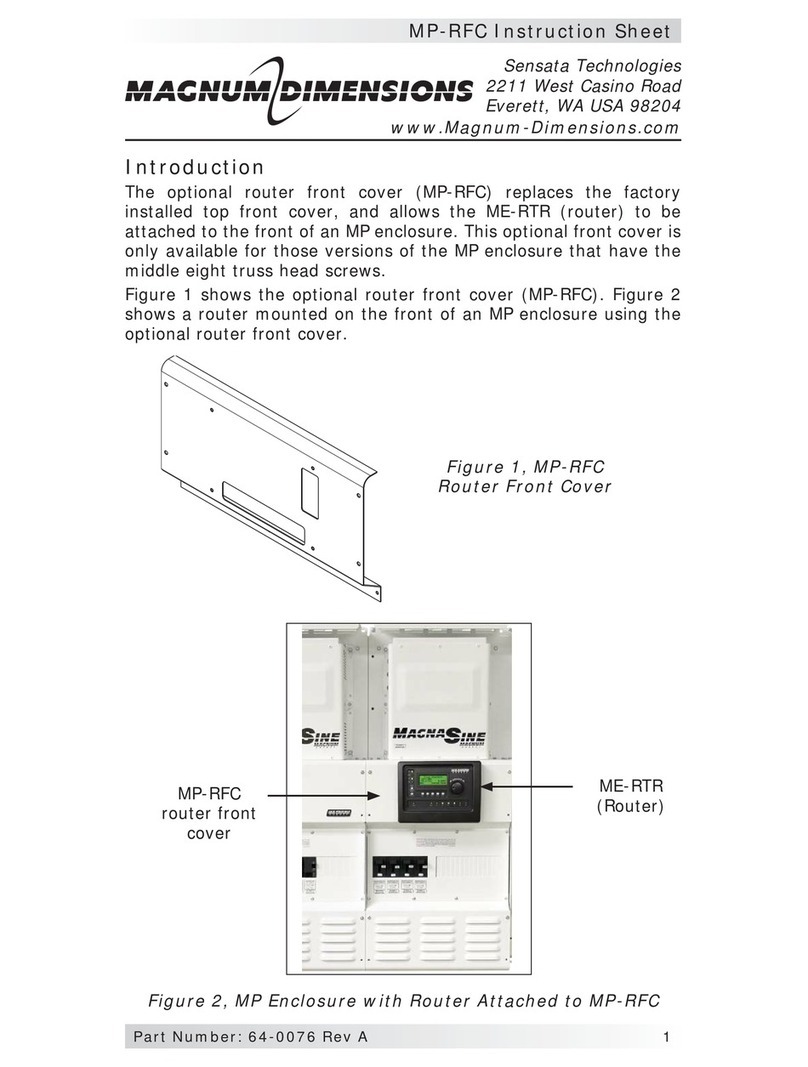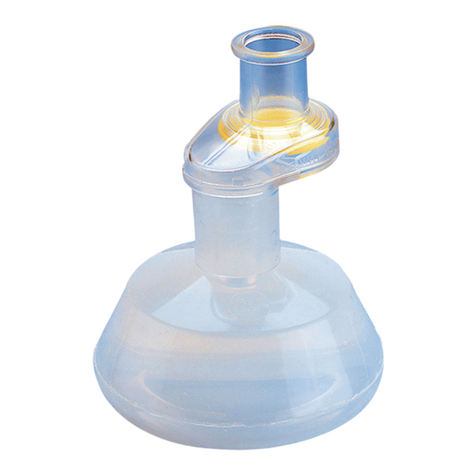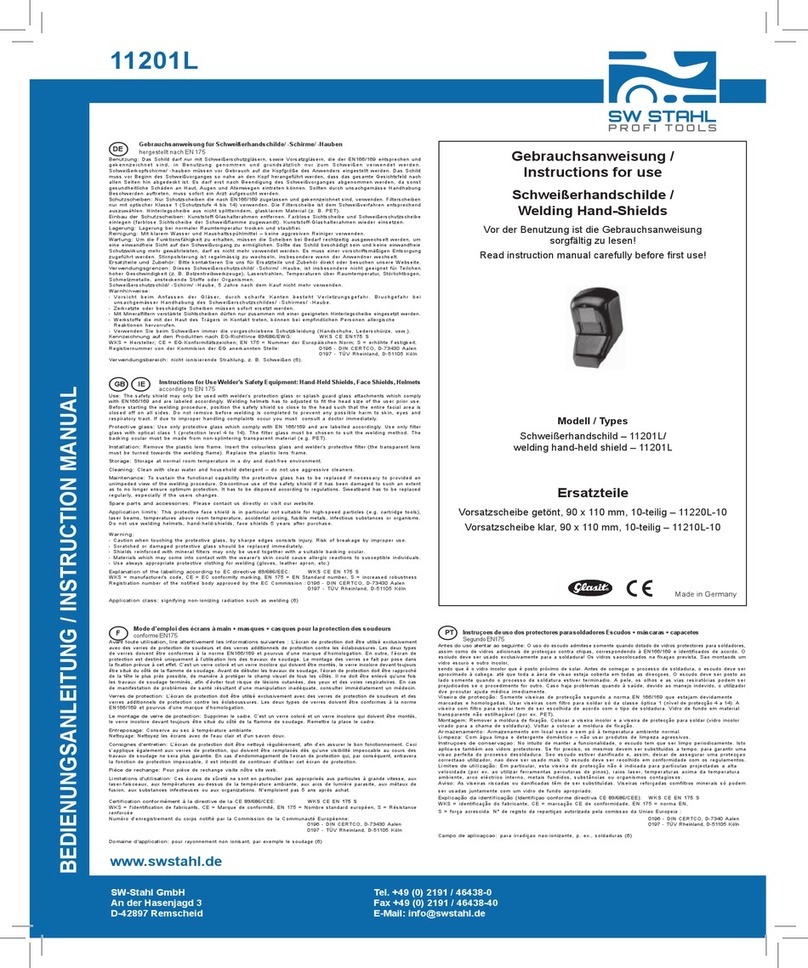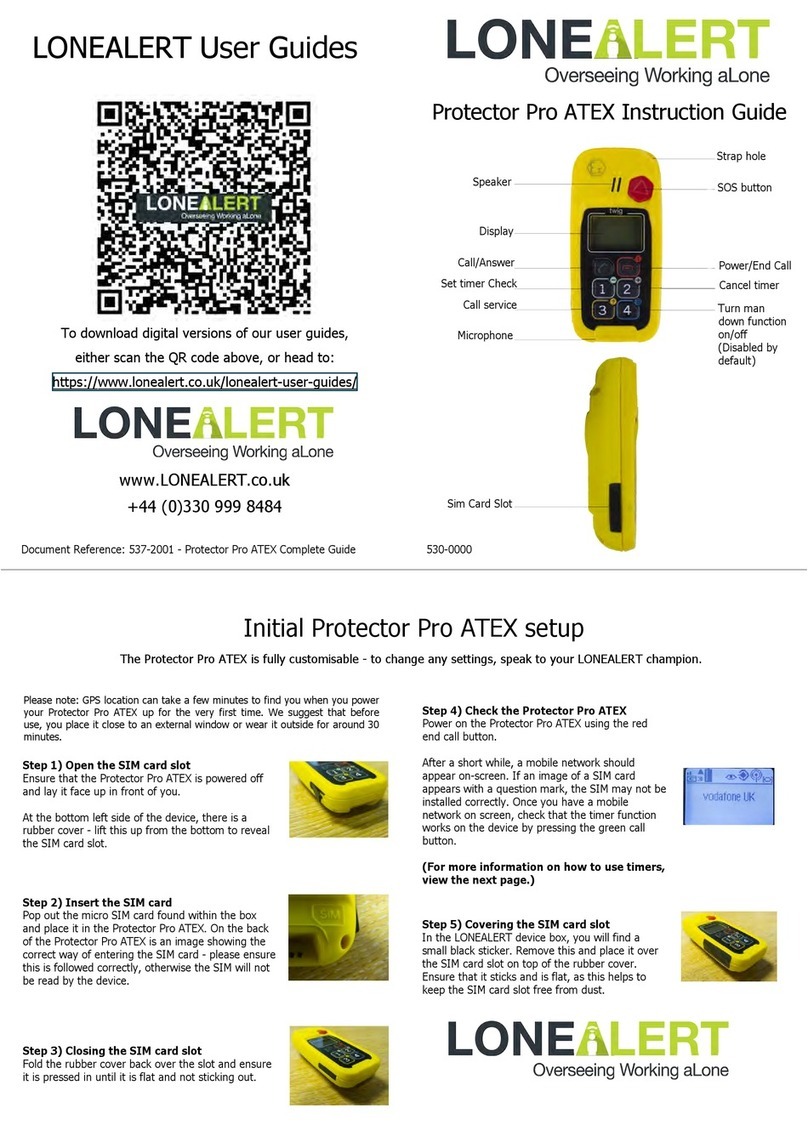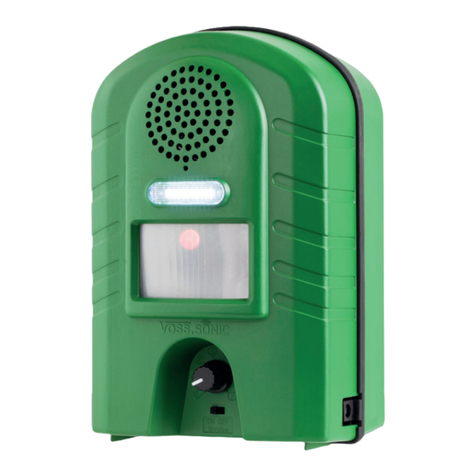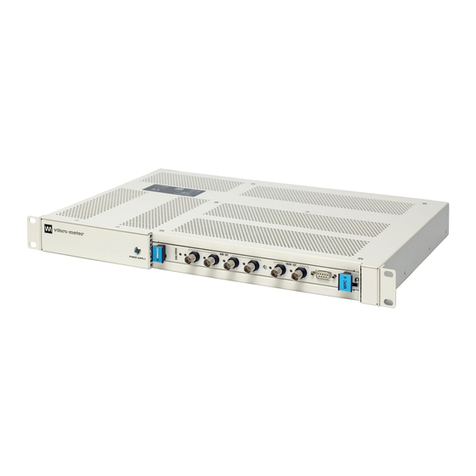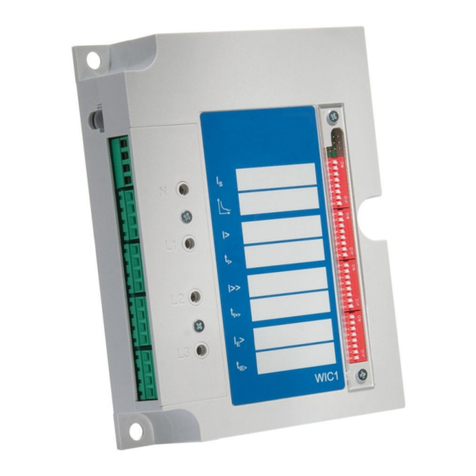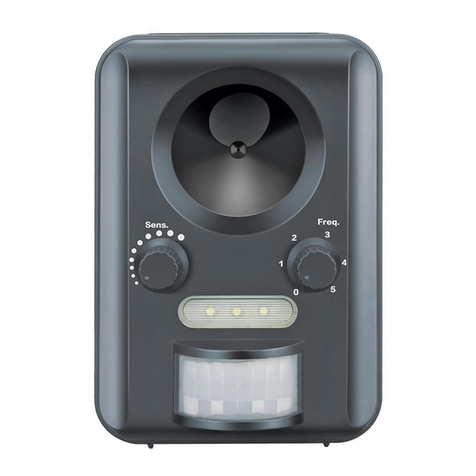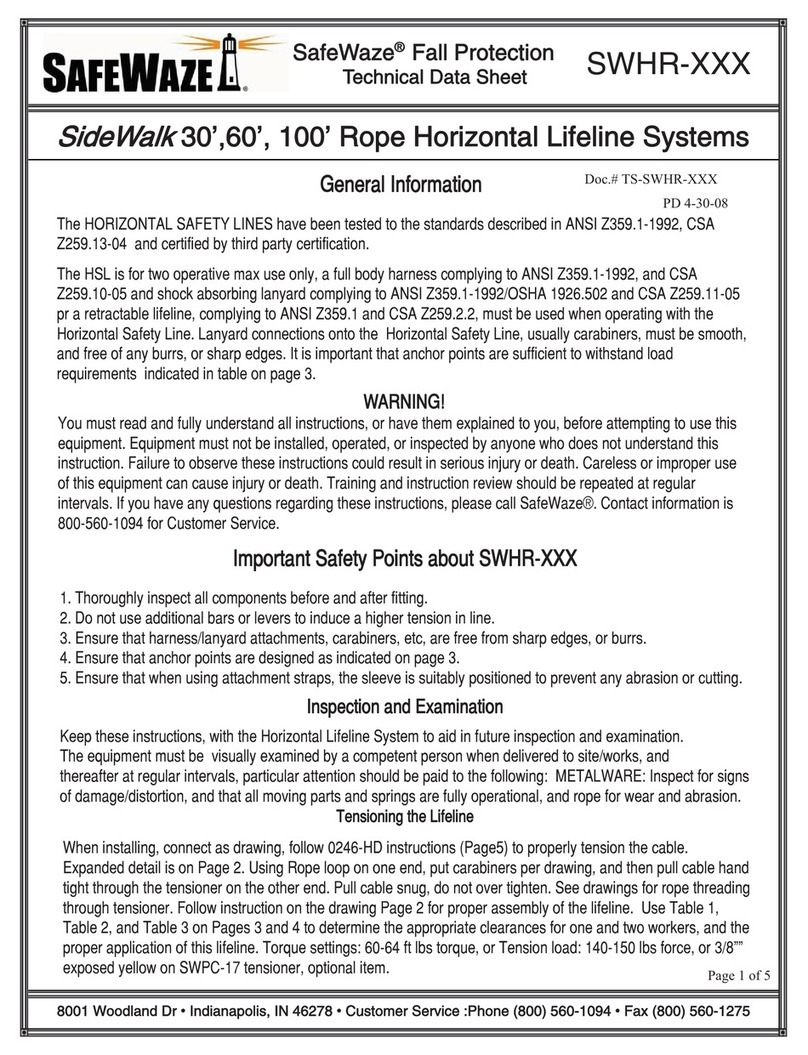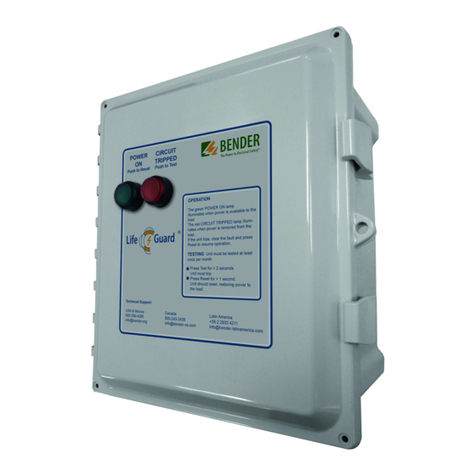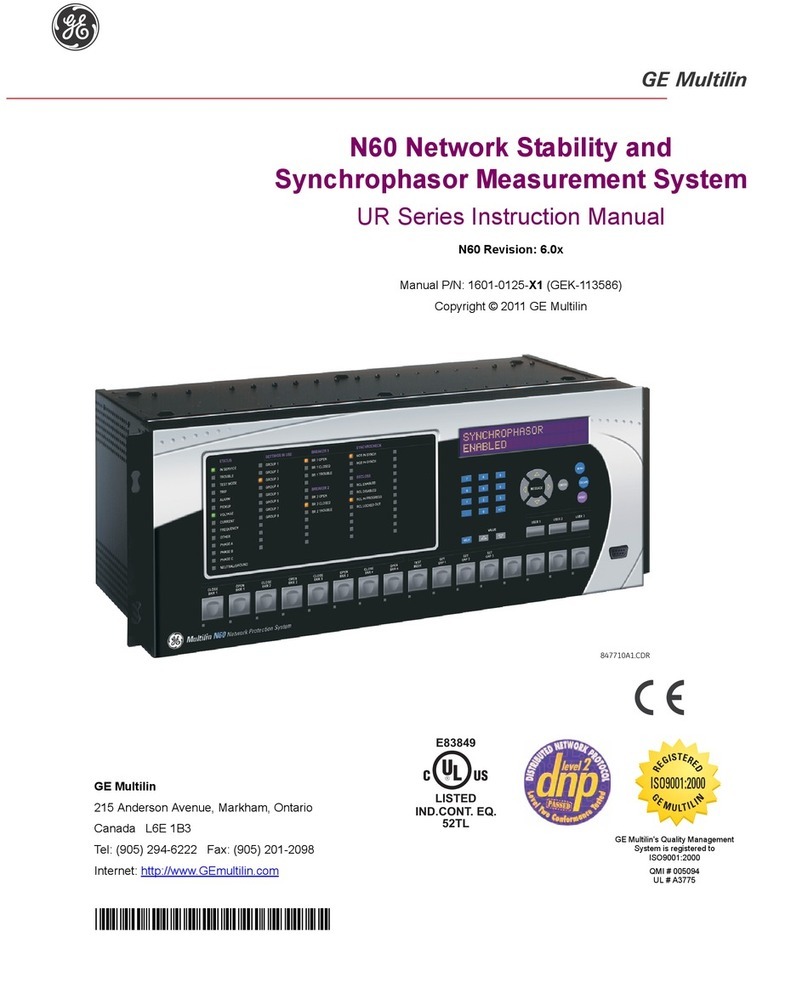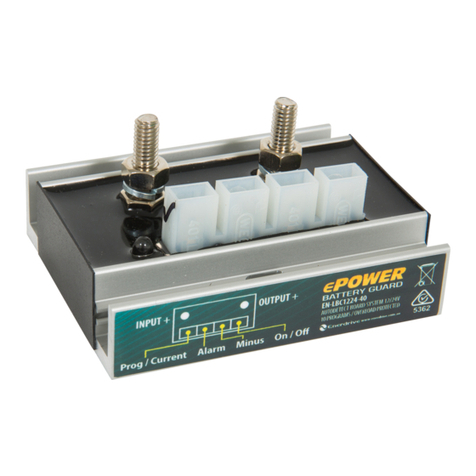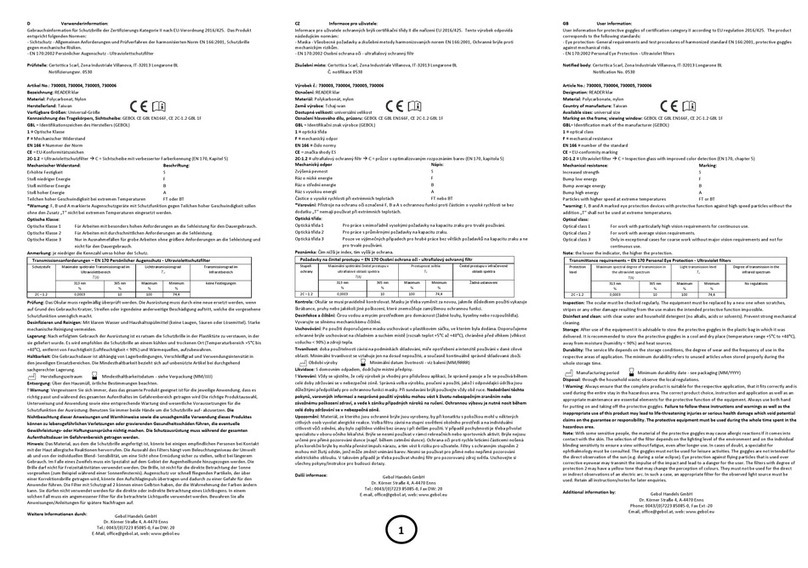Micom P631 User manual

MiCOM P631
Transformer Differential Protection Device
P631/EN M/R-11-C
Version P631 -310 -409/410 -650
Technical Manual


General Note on the PDF Version of this Technical Manual
All entries in the Table of Contents and all cross-references to other sections,
figures etc. in green letters are hyperlinks, i.e. by a single mouse click on the
reference one can navigate directly to the referenced part of the manual.
In the Adobe Reader (or the Acrobat Pro), one can return back to the previous
view by using the menu point View / Page Navigation / Previous View (keyboard
shortcut: ALT + Left cursor key). (It might be necessary to do this several times,
if the view at the target location has also been changed (e.g. by scrolling or
changing the zoom setting).


Warning!
⚫When electrical equipment is in operation dangerous voltage will be present in
certain parts of the equipment. Failure to observe warning notices, incorrect
use or improper use may endanger personnel and equipment and cause
personal injury or physical damage.
Before working in the terminal strip area, the P631 must be isolated. Where
stranded conductors are used, insulated crimped wire end ferrules must be
employed.
The signals MAIN: Blocked/faulty and SFMON: Warning (LED)
(permanently assigned to the LEDs labeled OUT OF SERVICE and ALARM) can
be assigned to output relays to indicate the health of the P631. Schneider
Electric strongly recommends that these output relays are hardwired into the
substation's automation system, for alarm purposes.
Any modifications to this P631 must be in accordance with the manual. If any
other modification is made without the express permission of Schneider
Electric, it will invalidate the warranty, and may render the product unsafe.
Proper and safe operation of this P631 depends on appropriate shipping and
handling, proper storage, installation and commissioning, and on careful
operation, maintenance and servicing.
For this reason only qualified personnel may work on or operate this P631.
The User should be familiar with the warnings in the Safety Guide
(SFTY/4LM/J11 or later version), with the warnings in Chapter 5, (p. 5-1),
Chapter 10, (p. 10-1), Chapter 11, (p. 11-1) and Chapter 12, (p. 12-1)
and with the content of Chapter 14, (p. 14-1), before working on the
equipment. If the warnings are disregarded, it will invalidate the warranty, and
may render the product unsafe.
Installation of the DHMI:
A protective conductor (ground/earth) of at least 1.5 mm² (US: AWG14 or
thicker) must be connected to the DHMI protective conductor terminal to link
the DHMI and the main relay case; these must be located within the same
substation.
To avoid the risk of electric shock the DHMI communication cable must not be
in contact with hazardous live parts.
The DHMI communication cable must not be routed or placed alongside high-
voltage cables or connections. Currents can be induced in the cable which
may result in electromagnetic interference.
Qualified Personnel are individuals who
●are familiar with the installation, commissioning and operation of the P631
and of the system to which it is being connected;
●are able to perform switching operations in accordance with safety
engineering standards and are authorized to energize and de-energize
equipment and to isolate, ground and label it;
●are trained in the care and use of safety apparatus in accordance with
safety engineering standards;
●are trained in emergency procedures (first aid).

Note This operating manual gives instructions for installation, commissioning and
operation of the P631. However, the manual cannot cover all conceivable
circumstances or include detailed information on all topics. In the event of
questions or specific problems, do not take any action without proper
authorization. Contact the appropriate technical sales office of Schneider Electric
and request the necessary information.
Any agreements, commitments, and legal relationships and any obligations on
the part of Schneider Electric, including settlement of warranties, result solely
from the applicable purchase contract, which is not affected by the contents of
the operating manual.

Changes after going to press


TABLE OF CONTENTS
1 APPLICATION AND SCOPE ................................................................................... 1-1
1.1 Overview - P631 ..........................................................................................................1-1
1.2 Including Function Groups in the Configuration ..........................................................1-3
1.3 Overview of Function Groups - Part 1 ......................................................................... 1-4
1.4 Overview of Function Groups - Part 2 ......................................................................... 1-6
1.5 Design .........................................................................................................................1-8
1.6 Configurable Function Keys ........................................................................................ 1-9
1.7 Inputs and Outputs ................................................................................................... 1-10
1.8 Control and Display ...................................................................................................1-11
1.9 Information Interfaces ...............................................................................................1-12
2 TECHNICAL DATA ................................................................................................2-1
2.1 Conformity ..................................................................................................................2-1
2.2 General Data ...............................................................................................................2-2
2.2.1 General Device Data ..................................................................................................................................... 2-2
2.3 Tests ...........................................................................................................................2-4
2.3.1 Type Tests .....................................................................................................................................................2-4
2.3.2 Routine Tests .................................................................................................................................................2-7
2.4 Environmental Conditions ...........................................................................................2-9
2.5 Inputs and Outputs ................................................................................................... 2-10
2.5.1 Current Measuring Inputs ............................................................................................................................2-10
2.5.2 Binary Signal Inputs .....................................................................................................................................2-11
2.5.3 IRIG‑B Interface ........................................................................................................................................... 2-12
2.5.4 Direct Current Input .....................................................................................................................................2-12
2.5.5 Resistance Thermometer ............................................................................................................................ 2-12
2.5.6 Direct Current Output ..................................................................................................................................2-12
2.5.7 Output Relays ..............................................................................................................................................2-13
2.5.8 BCD Measured Data Output ........................................................................................................................ 2-13
2.6 Interfaces ..................................................................................................................2-14
2.6.1 Local Control Panel ......................................................................................................................................2-14
2.6.2 PC Interface .................................................................................................................................................2-14
2.6.3 Serial Communication Interface .................................................................................................................. 2-14
2.6.4 IEC Communication Interface ......................................................................................................................2-15
2.6.5 IRIG‑B Interface ........................................................................................................................................... 2-15
2.7 Information Output ................................................................................................... 2-16
2.8 Settings – Typical Characteristic Data .......................................................................2-17
2.8.1 Main Function ..............................................................................................................................................2-17
2.8.2 Differential Protection ..................................................................................................................................2-17
2.8.3 Definite-Time and Inverse-Time Overcurrent Protection ............................................................................. 2-17
2.9 Deviations .................................................................................................................2-18
2.9.1 Deviations of the Operate Values ................................................................................................................2-18
2.9.2 Deviations of the Timer Stages ................................................................................................................... 2-19
2.9.3 Deviations of Measured Data Acquisition ....................................................................................................2-20
2.10 Resolution of the Fault Data Acquisition ...................................................................2-21
2.10.1 Time Resolution ...........................................................................................................................................2-21
2.10.2 Currents .......................................................................................................................................................2-21
2.10.3 Voltage ........................................................................................................................................................2-21
2.11 Recording Functions ................................................................................................. 2-22
P631
P631/EN M/R-11-C // P631-310-650 1

2.11.1 Organization of the Recording Memories .................................................................................................... 2-22
2.12 Power Supply ............................................................................................................ 2-24
2.13 Current Transformer Specifications .......................................................................... 2-25
2.13.1 Symbols .......................................................................................................................................................2-25
2.13.2 General Equations .......................................................................................................................................2-26
2.13.3 Transformer Differential Protection .............................................................................................................2-27
3 OPERATION .........................................................................................................3-1
3.1 Modular Structure .......................................................................................................3-1
3.2 Operator-Machine Communication ............................................................................. 3-3
3.3 Configuration of the Measured Value Panels (Function Group LOC) ........................... 3-4
3.3.1 Operation Panel .............................................................................................................................................3-5
3.3.2 Fault Panel .....................................................................................................................................................3-6
3.3.3 Overload Panel .............................................................................................................................................. 3-7
3.3.4 Configurable Clear Key ..................................................................................................................................3-7
3.4 Serial Interfaces ..........................................................................................................3-8
3.4.1 PC Interface (Function Group PC) .................................................................................................................. 3-9
3.4.2 Communication Interface 1 (Function Group COMM1) ................................................................................ 3-10
3.4.3 Communication Interface 2 (Function Group COMM2) ................................................................................ 3-19
3.4.4 Communication Interface IEC 61850 (Function Groups IEC, GOOSE and GSSE) ..........................................3-21
3.5 IRIG-B Clock Synchronization (Function Group IRIGB) ...............................................3-33
3.6 Configurable Function Keys (Function Group F_KEY) ................................................ 3-34
3.7 Configuration and Operating Mode of the Binary Inputs (Function Group INP) .........3-36
3.8 Measured Data Input (Function Group MEASI) ..........................................................3-38
3.8.1 Direct Current Input on the Analog (I/O) Module Y ...................................................................................... 3-39
3.8.2 Input for Connection of a Resistance Thermometer .................................................................................... 3-42
3.9 Configuration, Operating Mode, and Blocking of the Output Relays (Function Group
OUTP) ........................................................................................................................3-44
3.10 Measured Data Output (Function Group MEASO) ......................................................3-47
3.10.1 General Settings ..........................................................................................................................................3-47
3.10.2 BCD Measured Data Output ........................................................................................................................ 3-49
3.10.3 Analog Measured Data Output .................................................................................................................... 3-52
3.10.4 Output of “External” Measured Data ...........................................................................................................3-58
3.11 Configuration and Operating Mode of the LED Indicators (Function Group LED) ...... 3-59
3.11.1 Configuring the LED Indicators ....................................................................................................................3-59
3.11.2 Layout of the LED Indicators ........................................................................................................................3-59
3.11.3 Operating Mode of the LED Indicators .........................................................................................................3-60
3.12 Main Functions of the P631 (Function Group MAIN) ..................................................3-62
3.12.1 Conditioning of the Measured Values ..........................................................................................................3-62
3.12.2 Phase Reversal Function ..............................................................................................................................3-65
3.12.3 Operating Data Measurement ..................................................................................................................... 3-67
3.12.4 Configuring and Enabling the Device Functions .......................................................................................... 3-74
3.12.5 Activation of “Dynamic Parameters” ...........................................................................................................3-76
3.12.6 Multiple Blocking ......................................................................................................................................... 3-77
3.12.7 Multiple Signaling of the Measuring Circuit Monitoring Function .................................................................3-78
3.12.8 Blocked/Faulty .............................................................................................................................................3-79
3.12.9 Starting Signals and Tripping Logic .............................................................................................................3-79
3.12.10 Time Tagging and Clock Synchronization ....................................................................................................3-82
3.12.11 Resetting Actions .........................................................................................................................................3-84
3.12.12 Assigning Communications Interfaces to Physical Communications Channels ............................................3-87
3.12.13 Test Mode ....................................................................................................................................................3-88
3.13 Parameter Subset Selection (Function Group PSS) ................................................... 3-89
P631 Table of Contents
2 P631/EN M/R-11-C // P631-310-650

3.14 Self-Monitoring (Function Group SFMON) ..................................................................3-91
3.14.1 Tests During Start-up .................................................................................................................................. 3-91
3.14.2 Cyclic Tests ..................................................................................................................................................3-91
3.14.3 Signals .........................................................................................................................................................3-91
3.14.4 Device Response .........................................................................................................................................3-92
3.14.5 Monitoring Signal Memory ...........................................................................................................................3-93
3.14.6 Monitoring Signal Memory Time Tag ...........................................................................................................3-93
3.15 Operating Data Recording (Function Group OP_RC) ................................................. 3-94
3.16 Monitoring Signal Recording (Function Group MT_RC) ..............................................3-95
3.17 Overload Data Acquisition (Function Group OL_DA) ................................................. 3-96
3.17.1 Overload Duration .......................................................................................................................................3-96
3.17.2 Acquiring Measured Overload Data from the Thermal Overload Protection ................................................3-97
3.18 Overload Recording (Function Group OL_RC) ............................................................3-98
3.18.1 Start of Overload Recording ........................................................................................................................3-98
3.18.2 Counting Overload Events ...........................................................................................................................3-98
3.18.3 Time Tagging ...............................................................................................................................................3-98
3.18.4 Overload Logging ........................................................................................................................................ 3-99
3.19 Fault Data Acquisition (Function Group FT_DA) ...................................................... 3-100
3.19.1 Running Time and Fault Duration ..............................................................................................................3-100
3.19.2 Fault Data Acquisition Time .......................................................................................................................3-100
3.19.3 Acquisition of the Fault Currents ............................................................................................................... 3-102
3.19.4 Acquisition of the Differential and Restraining Currents ............................................................................3-102
3.19.5 Fault Data Reset ........................................................................................................................................3-103
3.20 Fault Recording (Function Group FT_RC) ................................................................ 3-104
3.20.1 Start of Fault Recording .............................................................................................................................3-104
3.20.2 Fault Counting ...........................................................................................................................................3-105
3.20.3 Time Tagging .............................................................................................................................................3-105
3.20.4 Fault Recordings ........................................................................................................................................3-106
3.20.5 Fault Value Recording ............................................................................................................................... 3-107
3.21 Differential Protection (Function Group DIFF) ......................................................... 3-109
3.21.1 Enabling or Disabling Differential Protection .............................................................................................3-109
3.21.2 Amplitude Matching ...................................................................................................................................3-110
3.21.3 Vector Group Matching ..............................................................................................................................3-113
3.21.4 Zero-sequence Current Filtering ................................................................................................................3-113
3.21.5 Tripping Characteristics .............................................................................................................................3-115
3.21.6 Rapid (high-set) Differential Protection ..................................................................................................... 3-117
3.21.7 Inrush Stabilization (Harmonic Restraint) ..................................................................................................3-118
3.21.8 Saturation Discriminator ............................................................................................................................3-119
3.21.9 Overfluxing Stabilization ........................................................................................................................... 3-120
3.21.10 Measured Operating Data of Differential Protection ..................................................................................3-121
3.22 Definite-Time Overcurrent Protection (Function Groups DTOC1 and DTOC2) .........3-123
3.22.1 Enabling or Disabling DTOC Protection ......................................................................................................3-123
3.22.2 Phase Current Stages ................................................................................................................................3-124
3.22.3 Negative-Sequence Current Stages ...........................................................................................................3-126
3.22.4 Residual Current Stages ............................................................................................................................3-127
3.22.5 General Starting ........................................................................................................................................3-129
3.22.6 Counters of the DTOC Protection Function ................................................................................................3-130
3.23 Inverse-time Overcurrent Protection (Function Groups IDMT1 and IDMT2) ............ 3-131
3.23.1 Enabling or Disabling IDMT Protection .......................................................................................................3-131
3.23.2 Time-Dependent Characteristics ............................................................................................................... 3-133
3.23.3 Phase Current Stage ..................................................................................................................................3-136
3.23.4 Negative-Sequence Current Stage ............................................................................................................ 3-138
3.23.5 Residual Current Stage ..............................................................................................................................3-140
3.23.6 Hold Time ..................................................................................................................................................3-142
Table of Contents P631
P631/EN M/R-11-C // P631-310-650 3

3.23.7 General Starting ........................................................................................................................................3-144
3.23.8 Counters of the IDMT Protection Function .................................................................................................3-144
3.24 Thermal Overload Protection (Function Group THRM1) .......................................... 3-145
3.24.1 Enabling or Disabling Thermal Overload Protection .................................................................................. 3-145
3.24.2 Readiness of Thermal Overload Protection ................................................................................................3-146
3.24.3 Tripping Characteristics .............................................................................................................................3-146
3.24.4 Coolant Temperature Acquisition .............................................................................................................. 3-147
3.24.5 Warning Signal .......................................................................................................................................... 3-148
3.25 Current Transformer Supervision (Function Group CTS) .........................................3-151
3.25.1 Hardware requirement .............................................................................................................................. 3-151
3.25.2 Enabling or Disabling the CTS Function .....................................................................................................3-151
3.25.3 Blocking CTS ..............................................................................................................................................3-151
3.25.4 Monitoring Condition ................................................................................................................................. 3-152
3.25.5 Signaling and Indication ............................................................................................................................3-153
3.25.6 Reset .........................................................................................................................................................3-154
3.25.7 Multiple Signaling from the CTS Function ..................................................................................................3-154
3.26 Measuring-Circuit Monitoring (Function Groups MCM_1 and MCM_2) ..................... 3-156
3.26.1 Enabling or Disabling Measuring-Circuit Monitoring ..................................................................................3-156
3.26.2 Measuring-Circuit Monitoring .....................................................................................................................3-156
3.26.3 Multiple Signaling from the Measuring-Circuit Monitoring Function .......................................................... 3-157
3.27 Circuit Breaker Failure Protection (Function Groups CBF_1 and CBF_2) ..................3-158
3.27.1 Assigning Transformer Ends ......................................................................................................................3-158
3.27.2 Assigning Circuit Breakers .........................................................................................................................3-158
3.27.3 Assigning the Trip Command .....................................................................................................................3-158
3.27.4 Enabling or Disabling the CBF Function .....................................................................................................3-158
3.27.5 Readiness of Circuit Breaker Protection .................................................................................................... 3-159
3.27.6 Detecting a CB Tripping .............................................................................................................................3-160
3.27.7 Current flow monitoring .............................................................................................................................3-160
3.27.8 Evaluation of CB Status Signals .................................................................................................................3-161
3.27.9 Startup Criteria ..........................................................................................................................................3-162
3.27.10 Trip Commands ......................................................................................................................................... 3-164
3.27.11 Starting Trigger ......................................................................................................................................... 3-164
3.27.12 Fault Behind CB Protection ........................................................................................................................3-165
3.27.13 CB Synchronization Supervision ................................................................................................................3-165
3.28 Limit Value Monitoring (Function Group LIMIT) .......................................................3-167
3.28.1 Enabling or Disabling the Limit Value Monitoring Function ....................................................................... 3-167
3.28.2 Monitoring the Linearized Measured DC Values ........................................................................................ 3-167
3.28.3 Monitoring the Measured Temperature Value ........................................................................................... 3-168
3.29 Limit Value Monitoring (Function Groups LIM_1 and LIM_2) ....................................3-170
3.29.1 Monitoring Minimum and Maximum Phase Currents ................................................................................. 3-170
3.30 Programmable Logic (Function Groups LOGIC and LOG_2) .....................................3-172
4 DESIGN ............................................................................................................... 4-1
4.1 Designs .......................................................................................................................4-2
4.2 Dimensional Drawings ................................................................................................ 4-4
4.2.1 Dimensional Drawings for the 40 TE Case .....................................................................................................4-4
4.2.2 Detachable HMI .............................................................................................................................................4-5
4.3 Hardware Modules ......................................................................................................4-7
5 INSTALLATION AND CONNECTION .......................................................................5-1
5.1 Unpacking and Packing ...............................................................................................5-2
5.2 Checking Nominal Data and Design Type ...................................................................5-3
5.3 Location Requirements ...............................................................................................5-4
P631 Table of Contents
4 P631/EN M/R-11-C // P631-310-650

5.3.1 Environmental Conditions ..............................................................................................................................5-4
5.3.2 Mechanical Conditions ...................................................................................................................................5-4
5.3.3 Electrical Conditions for Auxiliary Voltage of the Power Supply .................................................................... 5-4
5.3.4 Electromagnetic Conditions ...........................................................................................................................5-4
5.4 Installation ..................................................................................................................5-5
5.5 Protective and Operational Grounding ......................................................................5-11
5.6 Connection ................................................................................................................5-12
5.6.1 Connecting Measuring and Auxiliary Circuits .............................................................................................. 5-12
5.6.2 Connecting the IRIG‑B Interface .................................................................................................................. 5-14
5.6.3 Connecting the Serial Interfaces ................................................................................................................. 5-14
5.7 Location and Connection Diagrams .......................................................................... 5-18
5.7.1 Location Diagrams P631‑409/410 ................................................................................................................5-18
5.7.2 Terminal Connection Diagrams P631‑409/410 ............................................................................................ 5-18
6 LOCAL CONTROL (HMI) ....................................................................................... 6-1
6.1 Local Control Panel (HMI) ............................................................................................6-1
6.2 Display and Keypad .................................................................................................... 6-2
6.2.1 Text Display ...................................................................................................................................................6-2
6.2.2 Display Illumination .......................................................................................................................................6-2
6.2.3 Contrast of the Display ..................................................................................................................................6-2
6.2.4 Short Description of Keys .............................................................................................................................. 6-3
6.3 Display Levels .............................................................................................................6-5
6.4 Display Panels .............................................................................................................6-6
6.5 Menu Tree and Data Points .........................................................................................6-7
6.6 List Data Points ...........................................................................................................6-8
6.7 Note Concerning the Step-by-Step Descriptions .........................................................6-9
6.8 Configurable Function Keys ...................................................................................... 6-10
6.8.1 Configuration of the Function Keys F1 to Fx ................................................................................................6-11
6.9 Changing Between Display Levels ............................................................................ 6-14
6.10 Control at Panel Level ...............................................................................................6-15
6.11 Control at the Menu Tree Level .................................................................................6-16
6.11.1 Navigation in the Menu Tree ....................................................................................................................... 6-16
6.11.2 Switching Between Address Mode and Plain Text Mode ..............................................................................6-17
6.11.3 Change-Enabling Function ...........................................................................................................................6-18
6.11.4 Changing Parameters ..................................................................................................................................6-21
6.11.5 List Parameters ........................................................................................................................................... 6-22
6.11.6 Memory Readout .........................................................................................................................................6-25
6.11.7 Resetting .....................................................................................................................................................6-28
6.11.8 Password-Protected Control Actions ............................................................................................................6-29
6.11.9 Changing the Password ...............................................................................................................................6-31
7 SETTINGS ............................................................................................................7-1
7.1 Parameters .............................................................................................................. 7-1
7.1.1 Device Identification ............................................................................................................................. 7-3
7.1.2 Configuration Parameters .................................................................................................................. 7-11
7.1.3 Function Parameters ............................................................................................................................7-71
8 INFORMATION AND CONTROL FUNCTIONS ......................................................... 8-1
8.1 Operation .................................................................................................................8-1
8.1.1 Cyclic Values ............................................................................................................................................ 8-2
8.1.2 Control and Testing ..............................................................................................................................8-82
8.1.3 Operating Data Recording ..................................................................................................................8-92
Table of Contents P631
P631/EN M/R-11-C // P631-310-650 5

8.2 Events .....................................................................................................................8-93
8.2.1 Event Counters ...................................................................................................................................... 8-93
8.2.2 Measured Event Data ...........................................................................................................................8-96
8.2.3 Event Recording .................................................................................................................................... 8-99
9 IEC 61850 SETTINGS VIA IED CONFIGURATOR ....................................................9-1
9.1 Manage IED .................................................................................................................9-2
9.2 IED Details .................................................................................................................. 9-3
9.3 Communications .........................................................................................................9-4
9.4 SNTP ........................................................................................................................... 9-5
9.4.1 General Config ...............................................................................................................................................9-5
9.4.2 External Server 1 ...........................................................................................................................................9-5
9.4.3 External Server 2 ...........................................................................................................................................9-5
9.5 Dataset Definitions ..................................................................................................... 9-6
9.6 GOOSE Publishing .......................................................................................................9-7
9.6.1 System/LLN0 ................................................................................................................................................. 9-7
9.7 GOOSE Subscribing .....................................................................................................9-9
9.7.1 Mapped Inputs ...............................................................................................................................................9-9
9.8 Report Control Blocks ............................................................................................... 9-12
9.8.1 System/LLN0 ............................................................................................................................................... 9-12
9.9 Controls .....................................................................................................................9-13
9.9.1 Control Objects ............................................................................................................................................9-13
9.9.2 Uniqueness of Control ................................................................................................................................. 9-13
9.10 Measurements .......................................................................................................... 9-15
9.11 Configurable Data Attributes .................................................................................... 9-16
9.11.1 System/LLN0 ............................................................................................................................................... 9-16
10 COMMISSIONING ...............................................................................................10-1
10.1 Safety Instructions ....................................................................................................10-1
10.2 Commissioning Tests ................................................................................................10-3
10.2.1 Preparation ..................................................................................................................................................10-3
10.2.2 Testing .........................................................................................................................................................10-5
10.2.3 Checking the Binary Signal Inputs ...............................................................................................................10-5
10.2.4 Checking the Output Relays ........................................................................................................................10-5
10.2.5 Checking the Protection Function ................................................................................................................10-5
10.2.6 Completing Commissioning .........................................................................................................................10-9
11 TROUBLESHOOTING ..........................................................................................11-1
12 MAINTENANCE .................................................................................................. 12-1
12.1 Maintenance Procedures in the Power Supply Area ..................................................12-2
12.2 Routine Functional Testing ....................................................................................... 12-3
12.3 Analog Input Circuits .................................................................................................12-4
12.4 Binary Opto Inputs ....................................................................................................12-5
12.5 Binary Outputs ..........................................................................................................12-6
12.6 Serial Interfaces ........................................................................................................12-7
13 STORAGE .......................................................................................................... 13-1
14 ACCESSORIES AND SPARE PARTS .....................................................................14-1
P631 Table of Contents
6 P631/EN M/R-11-C // P631-310-650

15 ORDER INFORMATION .......................................................................................15-1
A1 FUNCTION GROUPS ...........................................................................................A1-1
A2 INTERNAL SIGNALS ...........................................................................................A2-1
A3 GLOSSARY ........................................................................................................ A3-1
Modules ......................................................................................................................................A3-1
Symbols ......................................................................................................................................A3-1
Examples of Signal Names ......................................................................................................... A3-7
Symbols Used .............................................................................................................................A3-8
A4 TELECONTROL INTERFACES ..............................................................................A4-1
A4.1 Telecontrol Interface per EN 60870-5-101 or IEC 870-5-101 (Companion Standard)
.................................................................................................................................. A4-1
A4.1.1 Interoperability ............................................................................................................................................A4-1
A4.2 Communication Interface per IEC 60870-5-103 ........................................................A4-9
A4.2.1 Interoperability ............................................................................................................................................A4-9
A5 P631 VERSION HISTORY ................................................................................... A5-1
Table of Contents P631
P631/EN M/R-11-C // P631-310-650 7

P631 Table of Contents
8 P631/EN M/R-11-C // P631-310-650

1 APPLICATION AND SCOPE
1.1 Overview - P631
The P631 differential protection device is intended for the fast and selective
short-circuit protection of transformers, motors, generators and other
installations with 2 windings.
Fig. 1-1: P631 in 40 TE case.
The P631 provides high-speed three-system differential protection using a triple-
slope characteristic and two high-set differential elements in combination with
transformer inrush restraint, overfluxing restraint and through-stabilization.
Amplitude and vector group matching is done just by entering the nominal values
of transformer windings and associated current transformers. An (optional)
overreaching current measuring circuit monitoring function will prevent
unwanted tripping by differential protection for faults in the CT's secondary
circuit.
Phase swapping allows motor / generator protection applications with enlarged
protection zones.
In addition many supplementary protective functions are incorporated in the
devices. These can be individually configured and cancelled.
The relevant protection parameters can be stored in four independent parameter
subsets in order to adapt the protection device to different operating and power
system management conditions.
During operation, the user-friendly interface makes it easy to set the device
parameters and allows safe operation of the substation by preventing non-
permissible switching operations.
These features give the user the means to adapt the P631 to the protection and
control capacity required in a specific application.
The powerful programmable logic provided by the protection device also makes
it possible to accommodate special applications.
P631
P631/EN M/R-11-C // P631-310-650 1-1

IY,b
IY,a
IP,a
IP,b 87
DIFF 49
THRM1
51
IDMT1
51
IDMT2
50
DTOC2
Metering
LIM_1
Overload rec.
Self Monitoring
LIM_2
Fault rec.
Communication
to SCADA / substation control / RTU / modem ...
via RS485 or Fiber optics
using IEC 60870-5-101, -103, Modbus, DNP3, Courier
resp.
via RJ45 or Fiber optics using IEC 61850
16S
COMM1 16S
COMM2 16E
IEC CLK
IRIGB
CMD_1SIG_1 26
MEASI MEASO Transformer Differential Protection
P631
Always availableOptional
LIMIT
50
DTOC1
50/62BF
CBF_2
50/62BF
CBF_1
MCM_2MCM_1
CTS
Recording and
Data Acquisition
LGC
LOGIC / LOG2
Fig. 1-2: Function diagram
For a list of all available function groups see the Appendix.
P631 1 Application and Scope
1-2 P631/EN M/R-11-C // P631-310-650

1.2 Including Function Groups in the Configuration
Functions listed in the tables in Section 1.3, (p. 1-4) are self-contained
function groups and can be individually configured or de-configured according to
the specific application requirements by using the MiCOM S1 operating program.
Unused or cancelled function groups are hidden to the user, thus simplifying the
menu of the MiCOM S1.
This concept provides a large choice of functions and makes wide-ranging
application of the protection device possible, with just one model version. On the
other hand, simple and clear parameter settings can be made.
In this way the protection and control functions can be included in or excluded
from the configuration.
Example For example, the current transformer supervision (function group CTS)
●can be included in the configuration by setting
CTS: Function group CTS to With
●can be excluded from the configuration by setting
CTS: Function group CTS to Without
1 Application and Scope P631
P631/EN M/R-11-C // P631-310-650 1-3

1.3 Overview of Function Groups - Part 1
The following tables list the function groups that can be included in or excluded
from the configuration of the P631.
✓= Standard; (✓) = Ordering option.
Protection functions
P631ANSI IEC 61850 Function group
Abbrev. Description
87T PhsPDIF1 DIFF Differential protection, phase selective 2 wind.
PHAR1 Inrush stabilization (functionality that is part of the
DIFF function group) ✓
50TD
P/ Q/ N DtpPhs- /
DtpEft- /
DtpNgsPTCO
x
DTOCx Definite-time overcurrent protection, 3 stages,
phase-, negative-sequence-, residual/starpoint-
overcurrent
2
51 P/
Q/ N ItpPhs- /
ItpEft- /
ItpNgsPTCOx
IDMTx Inverse-time overcurrent protection, one stage,
phase-, negative-sequence-, residual/starpoint-
overcurrent
2
49 ThmPTTR1 THRM1 Thermal overload protection 1
50 BF RBRFx CBF_x Circuit breaker failure protection 2
CTS Current transformer supervision 1
30/ 74 AlmGGIO1 MCM_x Measuring-circuit monitoring 2
LIMIT
LIM_x Limit value monitoring 2
LGC PloGGIOx LOGIC /
LOG_2 Programmable logic ✓
P631 1 Application and Scope
1-4 P631/EN M/R-11-C // P631-310-650
Table of contents
Other Micom Protection Device manuals

